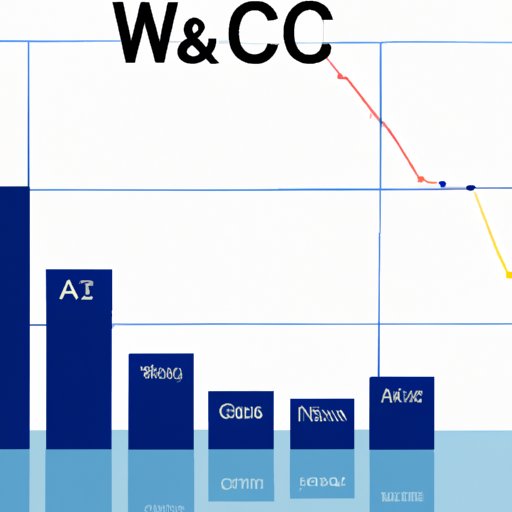Introduction
Weighted Average Cost of Capital (WACC) is an important concept in finance that measures a company’s cost of capital. It is used to calculate the rate of return required by a company’s investors and lenders in order to make an investment decision. Knowing WACC is essential for any investor or business looking to make sound financial decisions.
A Guide to Understanding the Basics of WACC in Finance
The basic idea behind WACC is simple: it is the average cost of all the capital that a company has invested in its operations. This includes both debt and equity financing. The cost of each type of capital is then weighted according to its proportion of the total capital invested.
Components of WACC
The components of WACC include the cost of debt, the cost of equity, the cost of preferred stock, the marginal tax rate, and the proportion of each type of capital. The cost of debt is the interest rate paid on borrowed funds, while the cost of equity is the return required by shareholders. The cost of preferred stock is the dividend rate paid to preferred shareholders, and the marginal tax rate is the rate at which the company pays taxes on its profits. Finally, the proportion of each type of capital is the portion of total capital invested in each type of financing.
Calculating WACC
Once the components of WACC are determined, calculating WACC is relatively straightforward. The formula for WACC is:
WACC = (Debt x (1- Tax Rate) x Cost of Debt) + (Equity x Cost of Equity) + (Preferred Stock x Cost of Preferred Stock)
In this formula, the cost of debt is the interest rate paid on borrowed funds, the cost of equity is the return required by shareholders, and the cost of preferred stock is the dividend rate paid to preferred shareholders.

WACC: Everything You Need to Know to Make Smart Investment Decisions
Knowing WACC can help investors and businesses make informed decisions about their investments. As the cost of capital increases, the return on investment decreases, making investments less attractive. Conversely, if the cost of capital decreases, the return on investment increases, making investments more attractive. Understanding WACC can help investors and businesses determine the optimal level of investment.
Benefits of WACC
There are many benefits to understanding WACC. First, it helps investors and businesses assess the risk associated with different investments. WACC takes into account the cost of capital, which is a major factor in determining the risk and return of an investment. Knowing WACC also helps investors and businesses compare the costs of different types of capital, such as debt and equity, and determine which type of financing is most cost effective. Finally, WACC provides a common metric for measuring the cost of capital across different companies. This makes it easier to compare the relative cost of capital between different companies and industries.
Limitations of WACC
Despite its usefulness, WACC is not without its limitations. For example, it does not take into account the time value of money, which is an important factor in assessing the risk and return of an investment. Additionally, WACC does not consider non-traditional sources of capital, such as venture capital or angel investing. Furthermore, WACC does not take into account the specific risk factors associated with a particular investment. For these reasons, it is important to supplement WACC with other methods of assessing risk and return.
WACC: Calculating an Organization’s Cost of Capital
Calculating WACC requires a few steps. First, the components of WACC must be determined, including the cost of debt, the cost of equity, the cost of preferred stock, the marginal tax rate, and the proportion of each type of capital. Next, the formula for WACC must be applied to calculate the overall rate of return required by investors and lenders. Finally, the results of the calculation should be interpreted and used to inform investment decisions.
Steps for Calculating WACC
The steps for calculating WACC are as follows:
- Determine the components of WACC, including the cost of debt, cost of equity, cost of preferred stock, marginal tax rate, and proportion of each type of capital.
- Apply the formula for WACC to calculate the overall rate of return required by investors and lenders.
- Interpret the results and use them to inform investment decisions.
Examples of Calculating WACC
To illustrate how WACC works, let’s look at the following example. A company has $100 million in debt, $50 million in equity, and a marginal tax rate of 25%. The cost of debt is 8%, the cost of equity is 10%, and the cost of preferred stock is 6%. The proportion of each type of capital is 50% debt, 25% equity, and 25% preferred stock. Applying the formula for WACC to this example yields a result of 8.5%. This means that the company must achieve a return of 8.5% on its investments in order to cover the cost of capital.

The Role of WACC in Financial Analysis and Valuation
WACC is an important concept for financial analysis and valuation. It can be used to assess the risk and return of different investments, as well as to compare the costs of different types of capital. In addition, WACC is often used to assess the cost of capital for a company, which can be used to determine the value of the company’s assets.
How WACC Can Help Assess Risk and Return
WACC can be used to assess the risk and return of different investments. By taking into account the cost of capital, WACC can provide insight into the expected return of an investment. Additionally, WACC can be used to compare the cost of different types of capital, such as debt and equity, and determine which type of financing is most cost effective.
Applying WACC to Financial Analysis and Valuation
WACC can also be used in financial analysis and valuation. By calculating the cost of capital for a company, investors can get an indication of the company’s value. WACC can also be used to assess the risk associated with different investments, which can help investors make informed decisions about their investments.
Analyzing Risk and Return with Weighted Average Cost of Capital (WACC)
Understanding WACC is essential for any investor or business looking to make sound financial decisions. WACC can be used to assess the risk and return of different investments, compare the costs of different types of capital, and assess the cost of capital for a company. Additionally, WACC can be used in financial analysis and valuation to help investors make informed decisions about their investments.
Uses of WACC
WACC can be used in a variety of ways. It can be used to assess the risk and return of different investments, compare the costs of different types of capital, assess the cost of capital for a company, and apply WACC to financial analysis and valuation. Knowing WACC can help investors and businesses make informed decisions about their investments.
Advantages of Using WACC
Using WACC can provide several advantages. It helps investors and businesses assess the risk associated with different investments, compare the costs of different types of capital, and determine the optimal level of investment. Additionally, WACC can be used to assess the cost of capital for a company, which can be used to determine the value of the company’s assets. Finally, WACC provides a common metric for measuring the cost of capital across different companies, which makes it easier to compare the relative cost of capital between different companies and industries.
Conclusion
Weighted Average Cost of Capital (WACC) is an important concept in finance that measures a company’s cost of capital. Knowing WACC can help investors and businesses make informed decisions about their investments. WACC can be used to assess the risk and return of different investments, compare the costs of different types of capital, and assess the cost of capital for a company. Additionally, WACC can be used in financial analysis and valuation to help investors make informed decisions about their investments. Overall, understanding WACC can help investors and businesses make sound financial decisions.
(Note: Is this article not meeting your expectations? Do you have knowledge or insights to share? Unlock new opportunities and expand your reach by joining our authors team. Click Registration to join us and share your expertise with our readers.)
